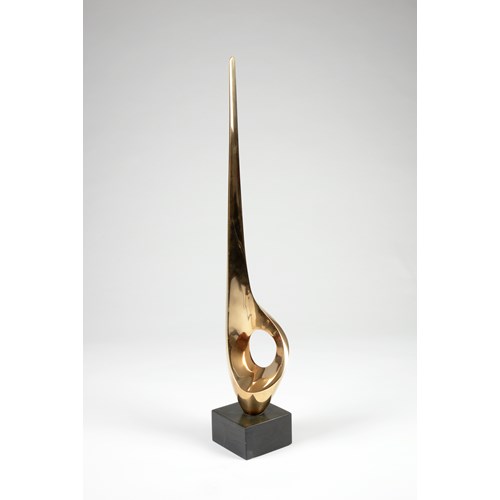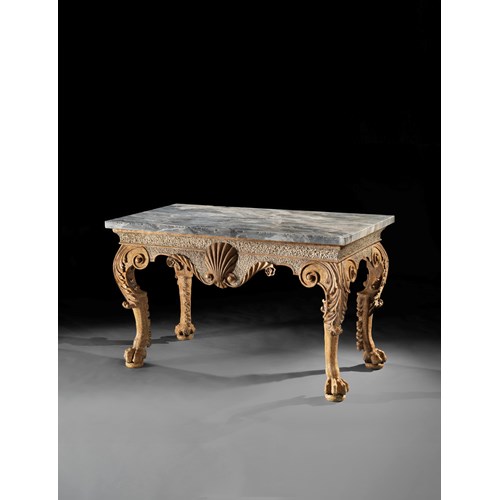Marketplace
A rare rosewood satinwood and carved giltwood side cabinet
A rare rosewood satinwood and carved giltwood side cabinet
Date circa 1810
Epoque Regency Period
Medium Rosewood satinwood and carved giltwood
Dimension 90 x 84 x 33.5 cm (35³/₈ x 33¹/₈ x 13¹/₄ inches)
REF894
The inverted breakfront top veneered in rosewood and cross-banded in West Indian satinwood over a frieze applied with gilt bronze mounts. The central door with glazed panel and brass moulding, flanked by two carved and gilded figures of the Horae, goddess of the day.
This exceptional cabinet combines outstanding craftmanship showcasing the work of the cabinet-maker, brass founder, carver and gilder. Whilst the maker of this piece is currently unknown, the two figures are almost identical to those on a side table in the Victoria & Albert Museum, designed by Thomas Hope for the Flaxman room in his house in Duchess Street. The drawings for this table are illustrated in Thomas Hope's 'Household Furniture and INterior Decoration' from 1807, playte 13.
This cabinet is a rare survival retaining its original surface, with an exceptional colour and patina and the figures retaining their original gilding.
Thomas Hope
Thomas Hope was born in 1769 and died in 1831. Of wealthy parents, he studied architecture when young in Italy, Greece and Egypt, which aroused in him a keen enthusiasm for classical work.
The patron for Canova, Flaxman and Thorwaldsen, and friend of the French architect Percier, he was one of the greatest of all European connoisseurs and collectors. His work, published in 1807, was intended as a description of his London house and its contents, decorated and furnished in Classical, Egyptian and French Empire style, and more than any other crystalized these influences into the English Regency style. Hope’s ideas were widely followed by Sheraton, George Smith and other designers and craftsman, and scholars, art-historians, connoisseurs, collectors, decorators and designers.
The inverted breakfront top veneered in rosewood and cross-banded in West Indian satinwood over a frieze applied with gilt bronze mounts. The central door with glazed panel and brass moulding, flanked by two carved and gilded figures of the Horae, goddess of the day.
This exceptional cabinet combines outstanding craftmanship showcasing the work of the cabinet-maker, brass founder, carver and gilder. Whilst the maker of this piece is currently unknown, the two figures are almost identical to those on a side table in the Victoria & Albert Museum, designed by Thomas Hope for the Flaxman room in his house in Duchess Street. The drawings for this table are illustrated in Thomas Hope's 'Household Furniture and INterior Decoration' from 1807, playte 13.
This cabinet is a rare survival retaining its original surface, with an exceptional colour and patina and the figures retaining their original gilding.
Thomas Hope
Thomas Hope was born in 1769 and died in 1831. Of wealthy parents, he studied architecture when young in Italy, Greece and Egypt, which aroused in him a keen enthusiasm for classical work.
The patron for Canova, Flaxman and Thorwaldsen, and friend of the French architect Percier, he was one of the greatest of all European connoisseurs and collectors. His work, published in 1807, was intended as a description of his London house and its contents, decorated and furnished in Classical, Egyptian and French Empire style, and more than any other crystalized these influences into the English Regency style. Hope’s ideas were widely followed by Sheraton, George Smith and other designers and craftsman, and scholars, art-historians, connoisseurs, collectors, decorators and designers.
Date: circa 1810
Epoque: Regency Period
Medium: Rosewood satinwood and carved giltwood
Dimension: 90 x 84 x 33.5 cm (35³/₈ x 33¹/₈ x 13¹/₄ inches)
Plus d'œuvres d'art de la Galerie









